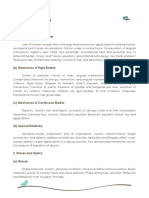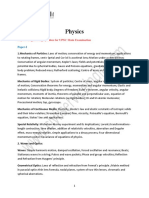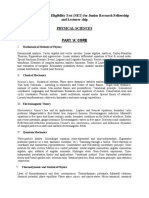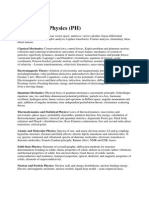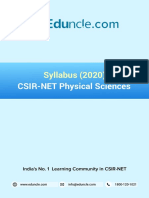CSIR
Uploaded by
Aloke RajkishoreCSIR
Uploaded by
Aloke RajkishoreCSIR-UGC National Eligibility Test (NET) for Junior Research Fellowship and Lecturer-ship I.
Mathematical Methods of Physics
Dimensional analysis; Vector algebra and vector calculus; Linear algebra, matrices, Cayley Hamilton theorem, eigenvalue problems; Linear differential equations; Special functions (Hermite, Bessel, Laguerre and Legendre); Fourier series, Fourier and Laplace transforms; Elements of complex analysis: Laurent series-poles, residues and evaluation of integrals; Elementary ideas about tensors; Introductory group theory, SU(2), O(3); Elements of computational techniques: roots of functions, interpolation, extrapolation, integration by trapezoid and Simpsons rule, solution of first order differential equations using Runge-Kutta method; Finite difference methods; Elementary probability theory, random variables, binomial, Poisson and normal distributions.
II. Classical Mechanics
Newtons laws; Phase space dynamics, stability analysis; Central-force motion; Two-body collisions, scattering in laboratory and centre-of-mass frames; Rigid body dynamics, moment of inertia tensor, non-inertial frames and pseudoforces; Variational principle, Lagrangian and Hamiltonian formalisms and equations of motion; Poisson brackets and canonical transformations; Symmetry, invariance and conservation laws, cyclic coordinates; Periodic motion, small oscillations and normal modes; Special theory of relativity, Lorentz transformations, relativistic kinematics and massenergy equivalence.
III. Electromagnetic Theory
Electrostatics: Gauss Law and its applications; Laplace and Poisson equations, boundary value problems; Magnetostatics: Biot-Savart law, Ampere's theorem, electromagnetic induction; Maxwell's equations in free Gauge invariance; Electromagnetic waves in free space, dielectrics, and conductors; Reflection and refraction, space and linear isotropic media; boundary conditions on fields at interfaces; Scalar and vector potentials; polarization, Fresnels Law, interference, coherence, and diffraction; Dispersion relations in plasma; Lorentz invariance of Maxwells equations; Transmission lines and wave guides; Dynamics of charged particles in static and uniform electromagnetic fields; Radiation from moving charges, dipoles and retarded potentials.
IV. Quantum Mechanics
Wave-particle duality; Wave functions in coordinate and momentum representations; Commutators and Heisenberg's uncertainty principle; Matrix representation; Diracs bra and ket notation; Schroedinger equation (time-dependent and time-independent); Eigenvalue problems such as particle-in-a-box, harmonic oscillator, etc.; Tunneling through a barrier; Motion in a central potential; Orbital angular momentum, structure; Time-independent perturbation theory and applications; Variational method; WKB approximation; Angular momentum algebra, spin; Addition of angular momenta; Hydrogen atom, spin-orbit coupling, fine
Time dependent perturbation theory and Fermi's Golden Rule; Selection rules; Semi-classical theory of radiation; Elementary theory of scattering, phase shifts, partial waves, Born approximation; Identical particles, Dirac equations. Pauli's exclusion principle, spin-statistics connection; Relativistic quantum mechanics: Klein Gordon and
V. Thermodynamic and Statistical Physics
Laws of thermodynamics and their consequences; Thermodynamic potentials, Maxwell relations; Chemical potential, phase equilibria; Phase space, micro- and macrostates; Microcanonical, canonical and grandcanonical ensembles and partition functions; Free Energy and connection with thermodynamic quantities; First- and second-order phase transitions; Classical and quantum statistics, ideal Fermi and Bose gases; Principle of detailed balance; Blackbody radiation and Planck's distribution law; Bose-Einstein condensation; Random walk and Brownian motion; Introduction to nonequilibrium processes; Diffusion equation.
VI. Electronics
Semiconductor device physics, including diodes, junctions, transistors, field effect devices, homo and heterojunction devices, device structure, device characteristics, frequency dependence and applications; Optoelectronic devices, including solar cells, photodetectors, and LEDs; High-frequency devices, including (registers, counters, comparators and similar circuits); A/D and D/A converters; Microprocessor and microcontroller basics. generators and detectors; Operational amplifiers and their applications; Digital techniques and applications
VII. Experimental Techniques and data analysis
Data interpretation and analysis; Precision and accuracy, error analysis, propagation of errors, least squares fitting, linear and nonlinear curve fitting, chi-square test; Transducers (temperature, pressure/vacuum, magnetic field, vibration, optical, and particle detectors), measurement and control; Signal conditioning and recovery, impedance matching, amplification (Op-amp based, instrumentation amp, feedback), filtering and modulation techniques. Applications of the above experimental and analytical techniques to typical undergraduate and graduate level laboratory experiments. noise reduction, shielding and grounding; Fourier transforms; lock-in detector, box-car integrator,
VIII. Atomic & Molecular Physics
Quantum states of an electron in an atom; Electron spin; Stern-Gerlach experiment; Spectrum of Hydrogen, helium and alkali atoms; Relativistic corrections for energy levels of hydrogen; Hyperfine structure and isotopic shift; width of spectral lines; LS & JJ coupling; Zeeman, Paschen Back & Stark effect; X-ray
spectroscopy; Electron spin resonance, Nuclear magnetic resonance, chemical shift; Rotational, vibrational, electronic, and Raman spectra of diatomic molecules; Frank Condon principle and selection rules; Spontaneous and stimulated emission, Einstein A & B coefficients; Lasers, optical pumping, population inversion, rate equation; Modes of resonators and coherence length.
IX. Condensed Matter Physics
Bravais lattices; Reciprocal lattice, diffraction and the structure factor; Bonding of solids; Elastic properties,
phonons, lattice specific heat; Free electron theory and electronic specific heat; Response and relaxation phenomena; Drude model of electrical and thermalconductivity; Hall effect and thermoelectric power; Diamagnetism, paramagnetism, and ferromagnetism; Electron motion in a periodic potential, band theory of metals, insulators and semiconductors; Superconductivity, type I and type - II superconductors, Josephson liquid crystalline order; Conducting polymers; Quasicrystals. junctions; Defects and dislocations; Ordered phases of matter, translational and orientational order, kinds of
X. Nuclear and Particle Physics
Basic nuclear properties: size, shape, charge distribution, spin and parity; Binding energy, semi-empirical mass formula; Liquid drop model; Fission and fusion; Nature of the nuclear force, form of nucleon-nucleon potential; Charge-independence and charge-symmetry of nuclear forces; Isospin; Deuteron problem; Evidence of shell structure, single- particle shell model, its validity and limitations; Rotational spectra; Elementary ideas of alpha, beta and gamma decays and their selection rules; Nuclear reactions, reaction mechanisms, compound nuclei and direct reactions; Classification of fundamental forces; Elementary particles (quarks, baryons, mesons, leptons); Spin and parity assignments, isospin, strangeness; Gell-Mann-Nishijima conservation in weak interaction; Relativistic kinematics. formula; C, P, and T invariance and applications of symmetry arguments to particle reactions, parity non-
You might also like
- Sol) Soild State Electronic Devices Chapter 2No ratings yetSol) Soild State Electronic Devices Chapter 27 pages
- Syllabus For PHD & M. Phil (Physics) at AMUNo ratings yetSyllabus For PHD & M. Phil (Physics) at AMU3 pages
- CSIR-UGC National Eligibility Test (NET) For Junior Research Fellowship and Lecturer-ShipNo ratings yetCSIR-UGC National Eligibility Test (NET) For Junior Research Fellowship and Lecturer-Ship3 pages
- Physics: Physics Engineering Syllabus For UPSC Main ExaminationNo ratings yetPhysics: Physics Engineering Syllabus For UPSC Main Examination4 pages
- Physics: Physics Engineering Syllabus For UPSC Main ExaminationNo ratings yetPhysics: Physics Engineering Syllabus For UPSC Main Examination4 pages
- CSIR-UGC National Eligibility Test (NET) For Junior Research Fellowship and Lecturer-Ship Physical SciencesNo ratings yetCSIR-UGC National Eligibility Test (NET) For Junior Research Fellowship and Lecturer-Ship Physical Sciences3 pages
- A.P. State Eligibility Test - 2012: Physical SciencesNo ratings yetA.P. State Eligibility Test - 2012: Physical Sciences3 pages
- Subject: Physical Sciences Code No.: 02 Gset Syllabus: Mathematical Methods of PhysicsNo ratings yetSubject: Physical Sciences Code No.: 02 Gset Syllabus: Mathematical Methods of Physics3 pages
- CSIR-UGC National Eligibility Test (NET) For Junior Research Fellowship and Lecturer-Ship Physical SciencesNo ratings yetCSIR-UGC National Eligibility Test (NET) For Junior Research Fellowship and Lecturer-Ship Physical Sciences3 pages
- CSIR-UGC National Eligibility Test (NET) For Junior Research Fellowship and Lecturer-Ship Physical SciencesNo ratings yetCSIR-UGC National Eligibility Test (NET) For Junior Research Fellowship and Lecturer-Ship Physical Sciences7 pages
- Syllabus For The Subject of Physics: Paper - 1 Total Marks: 100 MechanicsNo ratings yetSyllabus For The Subject of Physics: Paper - 1 Total Marks: 100 Mechanics3 pages
- Syllabus (2020) : CSIR-NET Physical SciencesNo ratings yetSyllabus (2020) : CSIR-NET Physical Sciences12 pages
- State Eligibility Test MP SET - 2018 Physical Sciences (Code No. - 15) Syllabus Paper - IiNo ratings yetState Eligibility Test MP SET - 2018 Physical Sciences (Code No. - 15) Syllabus Paper - Ii3 pages
- Laser Metrology in Fluid Mechanics: Granulometry, Temperature and Concentration MeasurementsFrom EverandLaser Metrology in Fluid Mechanics: Granulometry, Temperature and Concentration MeasurementsNo ratings yet
- Unit-II Nuclear Physics & Electron Balistics100% (1)Unit-II Nuclear Physics & Electron Balistics10 pages
- Result Analysis CT-II March 2011 Civil Branch1No ratings yetResult Analysis CT-II March 2011 Civil Branch12 pages
- Chemistry 285 Advanced Inorganic Chemistry: Lecture Notes Assoc. Prof. Joel R. SalazarNo ratings yetChemistry 285 Advanced Inorganic Chemistry: Lecture Notes Assoc. Prof. Joel R. Salazar102 pages
- CBSE Test Paper 02 Chapter 2 Units and MeasurementsNo ratings yetCBSE Test Paper 02 Chapter 2 Units and Measurements7 pages
- Gas Discharge Plasmas and Their ApplicationsNo ratings yetGas Discharge Plasmas and Their Applications17 pages
- DPP - ICSEClass 10 - Chemistry - Mole Concept & Stoichiometry - SolutionsNo ratings yetDPP - ICSEClass 10 - Chemistry - Mole Concept & Stoichiometry - Solutions9 pages









